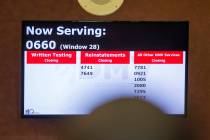EDITORIAL: Rand Paul offers path to a balanced budget
Saving your pennies will balance the budget, and Sen. Rand Paul, R-Ky., has the numbers to prove it.
Last week, Sen. Paul and Rep. Mark Sanford, R-S.C., introduced the Penny Plan Balanced Budget. It starts by rolling back February’s budget law, which suspended the sequestration cuts for two years. It would then reduce spending by 1 percent a year — a penny for every dollar spent — for five years without touching Social Security. This would balance the federal budget in five years. After that, spending would increase by 1 percent a year.
“Rather than holding hands and agreeing to the common gluttony,” Sen. Paul wrote, “this plan requires Congress to do the opposite: hold hands and sacrifice for the common good.”
There’s the rub. Sacrifice and prioritization aren’t easy, even when waste and inefficiency abound. Sen. Paul notes there are more than 200 programs promoting education in science, technology, engineering and math. There are also 160 housing assistance programs and 47 job-training programs. This isn’t a secret. The Government Accountability Office publishes an annual report on duplicative programs.
“These programs highlight exactly what is wrong with the current budget process and the incentive to spend,” wrote Sen. Paul. “Only in government would it make sense to create 47, 160 or 200 entities to tackle a problem, and the only reason it makes sense in government is politics.”
Requiring a paltry 1 percent reduction in government spending would force politicians and bureaucrats to streamline and save only the most effective programs. Is it really so draconian to have only 20 STEM plans? Of course not, but that context is ignored in political sound bites accusing budget hawks of hating education if they seek to reduce duplicative programs. Sen. Paul provides that context and more. Since 1962, payments to individuals, excluding Social Security and Medicare, have shot up more than 2,600 percent after adjusting for inflation. The U.S. population has increased 176 percent.
If that seems unsustainable, that’s because it is. Interest paid on the debt accounts for 7 percent of spending. In 30 years, that’ll grow to 19 percent. The federal budget is on cruise control with only one direction on the horizon — up.
Under Senate rules, any senator can offer a spending blueprint if the Budget Committee hasn’t produced one by April 1, and Sen. Paul says he plans to force a floor vote on his proposal. Good.
Politically, the plan will go nowhere. But symbolically, Sen. Paul’s proposal offers a means to identify those who are serious about imposing some sense of fiscal discipline on a federal government that has ballooned to massive proportions in recent decades and continues to grow uncontrollably. Nevada’s Dean Heller and Catherine Cortez Masto should support Sen. Paul’s proposal.




























